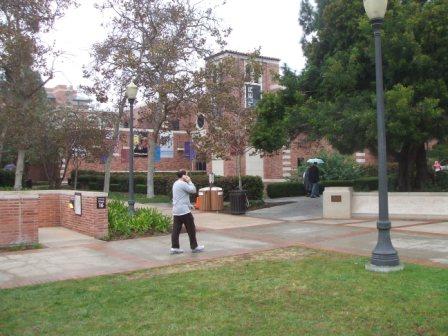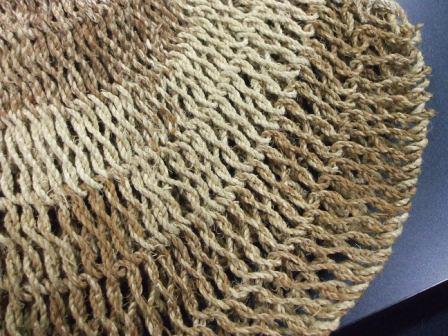
The campus is old, well established, cared for, and beautiful. The first thing I saw after parking my car in the underground lot and taking the elevator to ground level was Powell Library peeking through the trees.

The Fowler was only a short walk from where I landed and I wish I had parked in a more outlaying lot to enjoy the school.


But shortly, I came upon the museum.


I was greeted at the door and immediately sent to the basement where the lecture was to be held. There I met a friend who I didn't know was coming (she didn't know I was coming either) and then the others.

The lecture was given by a husband and wife team. I wish I could remember Mr. Kata's first name, but the primary artist was Cathy Kata. She lectured a while about the history and tradition of the Bilum while her husband passed samples around. After she was done, he took over, discussing the crossroads that they are at in New Guinea. How the culture has to decide whether it is going to remain in the past and maintain it's traditions, or leave it behind for modernism. No matter which way they ultimately choose, there will be things gained and things lost.
Once the lecture was complete, they demonstrated the process of making a bilum.

The Bast fiber with which they work comes from the bark of native twigs and bark. The needles with which they are woven are made of twigs, animal bone, or bamboo. A sign of the times came when they pulled out a commercial metal needle. They explained with wry smiles that they had packed the traditional materials to bring with them to the United States, but they had been confiscated at the airport. They had to buy needles at their first stop in San Francisco.

The fiber that is stripped out of the bark is thigh-spun. That's right. No spinning wheel. No drop spindle. On the thigh. I'd seen this done many years ago at a cheryl Samuels lecture about the Raven's Tail Cloaks of Alaska and have even tried it once or twice. Trust me, it's not as easy as Cathy made it look.

Fiber spun, it was time to thread the needle...

... and start making the loops. Again, Cathy made it look easy. One of the curators of the Museum in charge of this lecture noted that they had actually taught a workshop in San Francisco on making Bilums. When asked how it went, they guffawed quietly and softly commented - to our understanding laughter - that it had not gone so well. Nobody finished the project that they had intended; most had difficulty even understanding the process. As almost everyone attending the lecture did some kind of fiber craft, we knew how that went.

Cathy's hand is blurry because she really did move it that fast in creating the loops. And she informed us that she slowed down for the purpose of demonstrating!

A Bilum bag made of traditional natural fibers.

One made of natural Bast Fiber but dyed.

One interesting item of note to fiber artists... within the spinning and knitting community here, at least the circle in which I travel, we prize natural fibers and many look down on manufactured ones. It was a real clash of cultures as the Kata's were very proud of the fact that they now use Acrylic Yarns to make their Bilums. Here are a couple of samples.

The bag that the woman is holding was made by Cathy's mother and given to her 25 years ago. In New Guinea, it is a source of pride to have such an ornate Bilum to carry one's infant in. Her first son who is in college now, rode in it some 21 years ago.

The lecture over, we went upstairs and crossed the courtyard to visit the actual "Material Choices" exhibit. Unfortunately, no photographing within the exhibit allowed.

That was a shame because we were very excited over the fabrics that were on display. Many good ideas. But if you'd like to see a photo tour of the exhibit, click here.

No comments:
Post a Comment